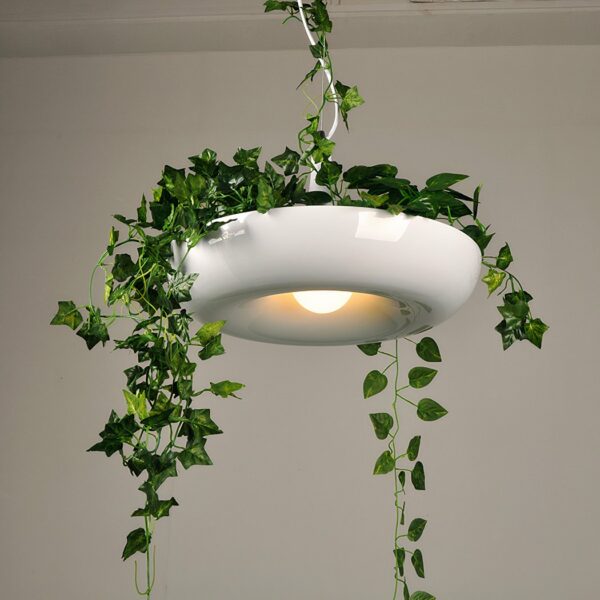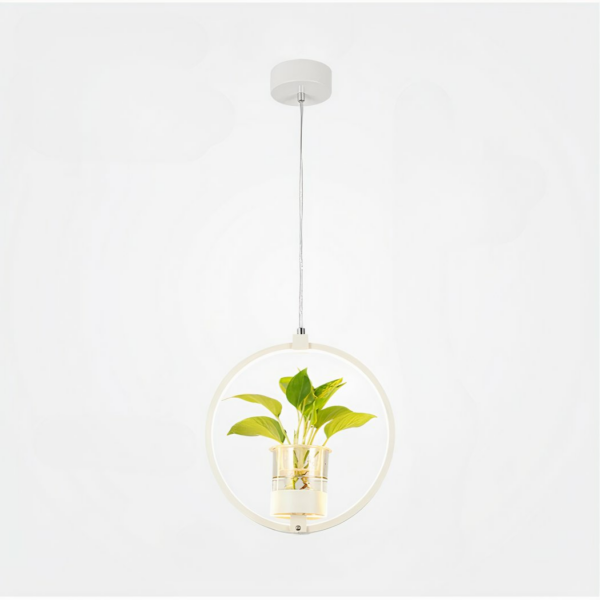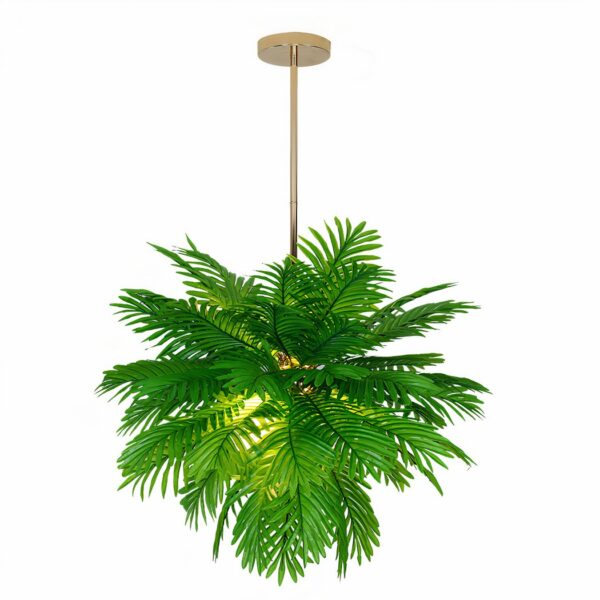Showing all 4 results
Showing all 4 results
Why are plant hangers all the rage?
The hanging garden plant pendant light is appealing to more and more people, and not by chance. They combine functionality and aesthetics to create lively, harmonious spaces. This trend is part of the wider biophilic design movement, which aims to integrate natural elements into interior environments to promote well-being. Plant pendants allow you to enjoy greenery without cluttering up living areas, which is particularly valuable in small urban spaces. What’s more, they offer the opportunity to grow herbs or flowers high up, away from pests and pets, making indoor horticulture both practical and aesthetically pleasing.
Benefits of hanging plants
Suspending your green plants frees up floor space and promotes better air circulation around the vegetation. This arrangement contributes to plant health and adds a vertical dimension to your decor. Another advantage of hanging plants is that they elevate your precious foliage away from the reach of pets or young children, reducing the risk of accidental damage. They also provide more even exposure to light, which is particularly beneficial for plants that require indirect light to thrive. Finally, hanging lights offer the advantage of creating a unique visual focal point in the room, drawing the eye to the often underutilized airspace.
Various styles and materials
The choice of materials and styles is vast, ranging from macramé to wood, rope and cotton. Macramé, with its intricate knots, inspires a bohemian aesthetic, while wooden pendant lights instill a natural, soothing ambience. Forged metal or ceramic options can add a touch of modern elegance or industrial refinement to your space. Rope and cotton supports, often handmade, add a unique texture and can be colored or natural to complement the ambient decor. What’s more, using recycled or upcycled materials for plant hangers not only supports sustainability but also introduces an element of history and character into your home’s interior design.
How to select the perfect hanging garden plant pendant light for your plants ?
There’s a lot more to choosing a plant hanging lamp than its appearance. Several criteria come into play to ensure you make the right choice.
Space and room considerations
The location of the suspension greatly influences its size and style. Assess the space where the plant will be hung. Make sure that the chosen hanging arrangement blends in harmoniously with the interior or exterior décor, and that the location allows adequate exposure to natural light, which is essential for the plant’s health. Think about ease of watering and maintenance, opting for materials that are resistant to humidity and easy to clean. What’s more, materials should be suited to climatic conditions: macramé or rattan hanging baskets are ideal for indoor spaces, while hard-wearing materials such as galvanized metal or recycled plastic are more suitable for outdoor use. In a small space, a simple, unobtrusive pendant will do the trick. For larger rooms, a solar suspension will bring a bright, spacious touch to your garden or balcony.
Criteria for choice : from wire to pot
The type of plant, the pot material and even the color of the wire are all elements to consider. For a modern, on-trend look, opt for a hanging LED circle light with plant vase. This choice combines functionality and aesthetics, ideal for contemporary interiors. To make the right choice, consider the weight and future growth of the plant. Hangers need to be able to support the plant’s current weight, as well as accommodate it as it grows. Plastic pots are lightweight and therefore easier to hang, while terracotta or ceramic pots require sturdier hangers. Suspension systems with steel cables or chains are ideal for heavy plants. Don’t forget that safety is paramount; make sure that the anchoring point in the ceiling or wall is strong enough to support the weight of the hanging unit. By following these tips, you can not only beautify your space but also ensure the well-being of your hanging plants.
The ideal hanging garden plant pendant light set for every space
Every space has its own needs and constraints, and there’s a plant suspension that perfectly meets them. Whether you have a sunny window, a shady corner or a workspace that needs a little greenery, there’s a suspension option to suit. For bright spaces, hanging baskets with terracotta pots provide good root aeration and Mediterranean style. In less sunny areas, opt for hanging baskets suitable for shade plants such as pothos or philodendron, which thrive in low light. For modern offices or living spaces, geometric metal pendants or industrial designs can add contemporary character while integrating nature into the design of the space.
Solar suspension for a bright garden
For those looking to brighten up their outdoor space, solar suspensions are a smart choice. Not only does it provide eco-friendly solar lighting, it also adds a touch of elegance to your garden. They capture the sun’s energy during the day and transform into twinkling lanterns as night falls, creating a magical atmosphere. What’s more, they are often equipped with twilight sensors, lighting up automatically when they detect a drop in luminosity, offering convenience and energy savings. They represent a sustainable solution, reducing electricity consumption and lowering the carbon footprint. What’s more, these solar suspensions are generally designed to withstand the outdoor elements, ensuring durability and longevity, even in variable climatic conditions.
Hanging LED lamp with plant vase for a modern interior
If you want to add a contemporary touch to your interior, hanging LED lamps are the ideal solution. They combine low-energy lighting with a vase for your plants, creating a multifunctional decorative element. Their sleek design blends perfectly into minimalist or industrial spaces, adding a touch of greenery and light. These lamps use long-life LEDs that enhance the natural beauty of plants while serving as a main or accent light source. What’s more, they can often be adjusted for height or light intensity, offering flexibility to suit the desired mood or activity taking place in the room.
FAQ Suspension Plant
Which plant to suspend?
Hanging plants such as Pothos, Misery or Ceropegia woodii are ideal for hanging baskets. They create a cascading effect that adds dynamism to your space. Species such as Ficus pumila or certain fern varieties also add interesting texture and volume when suspended. For those looking for a colorful touch, plants such as begonias or chlorophytums provide variegated foliage or delicate flowers that stand out elegantly in height. It’s also important to choose plants that adapt well to the specific indoor environment, taking into account the brightness, humidity and temperature variations of the space.
How to hang houseplants
Use ceiling hooks or wall shelves to hang your plants. Make sure the support is sturdy enough and that the plant receives sufficient light. For a more interesting visual effect, vary the heights by playing with the length of the hanging ropes or chains. Also consider access for watering and plant maintenance; a plant suspended too high could make these tasks difficult without the use of a stepladder or pole.
How to hang a plant?
Choose a pot with a drainage hole and use a strong rope or wire cable to hang it. Attach it to a ceiling hook or rod. Be sure to anchor the hook in a ceiling stud, or use a suitable anchor to ensure the safety of your installation. It’s also a good idea to place a saucer or receptacle under the pot to catch excess water and protect your floors from any watering splashes.
How to hang a plant without making a hole?
Use adhesive wall brackets specially designed to support the weight of plants, or opt for floating shelves that can be attached without drilling into the wall. Alternatively, hang plants from a curtain rod in front of a window to avoid permanent wall modifications. For those who prefer a mobile solution, stands or plant holders on legs with hanging sections are an alternative that requires no fixed spatial commitment.



